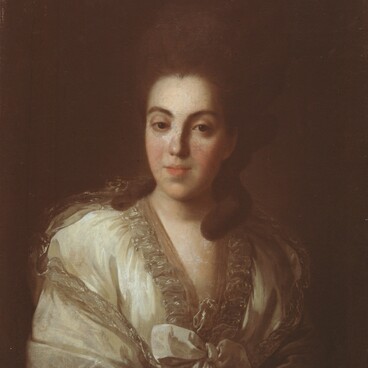The parsuna genre emerged in Russia at the turn of 18th century as a transition from icon painting to secular portraits. The word derives from the distorted “persona” — that was the Russian word for European portraits. The first Russian parsunas were painted in accordance with icon-painting traditions by the masters of the Armory Chamber of the Moscow Kremlin. The parsuna genre does not demand a likeness in a portrait: it is more important to depict the model’s dignity and social status.
Parsuna of Marfa Sobakina
Creation period
the late 17th — 1st half of the 18th century
Dimensions
88x70 cm
Technique
canvas, oil
Exhibition
3
Open in app#2
#4
Unlike the realistic European portrait of the 17th century, the people that are depicted in a parsuna do not belong to themselves, just like in the case of an icon. The model is forever withdrawn from the flow of time, but at the same time, the person’s face is turned not to God, but to reality.
Lev Isaakovich Lifshits, doctor of art history at the Russian State Humanitarian University
#5
The parsuna of Marfa Sobakina entered the Ulyanovsk Regional Art Museum in 1901. It was donated by N.A. Ivanov, a landowner from the village of Sobakino.
Marfa Vasilyevna Sobakina was the daughter of a Kolomna nobleman and the third wife of Ivan the Terrible. Twice a widower, the tsar personally chose Marfa at a traditional bride show. Immediately after the betrothal in the summer of 1571, the young woman fell seriously ill and began to “wither.” The wedding took place in the autumn, and 15 days later, the young wife died. The exact cause of death remained unknown, but Ivan the Terrible’s first two wives had been poisoned. During the investigation into the death of Marfa Sobakina, the tsar ordered that 20 people be executed, including the young woman’s mother and brothers.
Until the 19th century, there was a tradition to depict the wives of Russian tsars as nuns. Sobakina’s hand gesture resembles the traditional gesture of the Virgin from the scenes of the Annunciation. Marfa’s face is calm and full of spiritual contemplation. The woman’s thin fingers of the left hand point upwards — they seem to “disappear” into the background of her black mantle. This gesture came to the parsuna from icon painting. It was used to depict the righteous, and it symbolized sincerity and purity of thoughts. In Marfa’s parsuna, this gesture combines the renunciation of the world and high spirituality.
Marfa’s pale face and hands are painted against the black background of her clothes. Her features provide a strong contrast of chiaroscuro and look radiant. Her trembling lips, her gaze that is directed into the distance and her self-absorption — these are all signs of a new time in the art of portrait painting. They express the artist’s desire to convey a special psychological state. Below there is a cartouche with the following inscription: “Marfa Vasilyevna Sobakina in the nuns Jonah, the former tsarina, the third wife of Tsar Ivan Vasilyevich, called the Terrible.”
Marfa Vasilyevna Sobakina was the daughter of a Kolomna nobleman and the third wife of Ivan the Terrible. Twice a widower, the tsar personally chose Marfa at a traditional bride show. Immediately after the betrothal in the summer of 1571, the young woman fell seriously ill and began to “wither.” The wedding took place in the autumn, and 15 days later, the young wife died. The exact cause of death remained unknown, but Ivan the Terrible’s first two wives had been poisoned. During the investigation into the death of Marfa Sobakina, the tsar ordered that 20 people be executed, including the young woman’s mother and brothers.
Until the 19th century, there was a tradition to depict the wives of Russian tsars as nuns. Sobakina’s hand gesture resembles the traditional gesture of the Virgin from the scenes of the Annunciation. Marfa’s face is calm and full of spiritual contemplation. The woman’s thin fingers of the left hand point upwards — they seem to “disappear” into the background of her black mantle. This gesture came to the parsuna from icon painting. It was used to depict the righteous, and it symbolized sincerity and purity of thoughts. In Marfa’s parsuna, this gesture combines the renunciation of the world and high spirituality.
Marfa’s pale face and hands are painted against the black background of her clothes. Her features provide a strong contrast of chiaroscuro and look radiant. Her trembling lips, her gaze that is directed into the distance and her self-absorption — these are all signs of a new time in the art of portrait painting. They express the artist’s desire to convey a special psychological state. Below there is a cartouche with the following inscription: “Marfa Vasilyevna Sobakina in the nuns Jonah, the former tsarina, the third wife of Tsar Ivan Vasilyevich, called the Terrible.”
#3
Ministry of Culture of the Russian Federation
read morehide
00:00
00:00
1x
Parsuna of Marfa Sobakina
Creation period
the late 17th — 1st half of the 18th century
Dimensions
88x70 cm
Technique
canvas, oil
Exhibition
3
Open in app
Share



